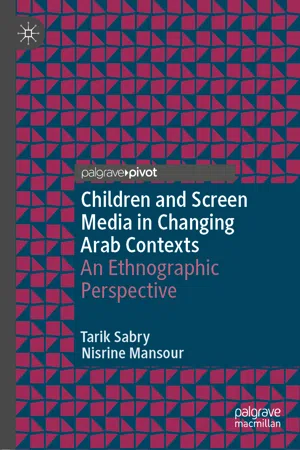Arab Child Populations in Context(s)
In the summer of 2014, we held a
creative workshop with 9- to 12-year-old children in
Casablanca with the purpose to understand children’s everyday use of
screen media . Focusing on world news, researchers and participants engaged in the following discussion:
- Nisrine:
do you watch the news?
- Boy 1:
I don’t like watching the news, it is all about war and poor children being killed. What is happening to the children in Gaza is horrible.
- Girl 1:
It makes me very sad, you see blood everywhere, children’s remains are scattered across the streets.
- Nisrine:
So, who is fighting in Gaza ?
- Boy 2:
It is the rebels against the regime.
(Creative Workshop 4, Casablanca, July 2014)
These recollections threw serious questions as to how we approach researching ‘Arab ’ children and media use in today’s devastatingly charged, hyper-mediated, and trans-temporal contexts. It compelled us to wonder, how a child born and bred in Morocco , the farthest corner of the shifting pan-Arab geo-political map, relates to, and understands, the bloodiness of the Israeli–Palestinian conflict. At the time of the fieldwork , the 2014 Israeli offensive on Gaza confirmed that the conflict remains at the heart of the Arab nationalist cause amid the overlapping layers of more recent conflicts ripping the region.
To give an idea of this overlapping layering, the
encounter with the children came at midpoint of our
ethnographic inquiry into
Arab children’s
media use , which rolled over three summers between 2013 and 2015 in three contextually disparate sites of
London ,
Casablanca , and
Beirut . These three summers of
fieldwork were punctuated by the withering euphoria of the
Arab revolts and unprecedented escalation of violence in
Syria , Yemen,
Iraq , and Libya (2013), a major offensive by Israel over
Gaza (2014), serial car bombings in
Lebanon (2014), and the ravaging effect of the
Syrian conflict on its populations, leading to the mass and often deadly exodus of
refugees on the shores of Europe (2015). As these seismic events are wrapping the
Arab region, their impact on children’s
experiences and views of the world tend to be overlooked as
Sonia Livingstone (
2002: 25) pointed in the
Young People New Media Project:
Rather than see children as the object of media effects , they are instead seen as actors in the household and community , co-constructors of the meanings and practices of their everyday lives. Indeed, if we forget to see young people as actors as well as acted upon, if we fail to listen to participants’ voices as they speak for themselves…we miss understanding their experience of the media, tending to succumb to our often-nostalgic perspective on childhood and so missing the new skills and opportunities that these media may open for them.
There is no doubt that the Arab region is going through major socio-political and cultural changes that are tearing down the foundations of nationalist narratives that made up the post-colonial raison d’être of Arab nationalism . These violent changes are remodelling national, religious, and cultural identities. Palestine used to be the beacon of a regional Arab national identity embraced by succeeding generations across the Arab region as they grew up under nationalist regimes that championed the Palestinian cause as the heart of their often autocratic raison d'être. In the early phase of the dispossession of Palestinians , tensions between and within Arab nations were pushed under the carpet of a unified front in the fight against the forceful establishment of Israel in 1948. Following several defeats and victories, Arab states gradually broke and warmed up to Israel with peace accords struck in Egypt (1979), Morocco (1994), and Jordan (1994), and trade relations established in Gulf countries. 1 These peace accords brought overarching state narratives of non-interventionism, crushing overt political engagement, and any official narratives of solidarity of their populations with the Palestinian cause. More recent conflicts and destabilisation by regional and international players, such as the US, Europe, Russia, Turkey, Iran, and Gulf countries, resulted in the rise of Islamist military ideologies that fragmented narratives of Muslim unity for Palestine —the other prime marker of Arab nationalism . The recent Arab revolts and the toppling (or near toppling) of long-standing dictators also uncovered an enduring malaise about decades of oppression and grievances that older and younger generations have endured for periods as long as 42 years in some cases, as in the example of Ghaddafi’s Libya, or the long-established (near) absolutist governance models of Gulf countries. The ravaging instability following from them added layers of complexity and incoherence to an already charged and fractured Arab identity.
In parallel to political hegemony, Arab regimes have actively and systematically imposed neo-liberal frameworks of economic governance, with deep effects on populations. In the decade preceding the recent Arab revolts, several regimes gradually dropped their socialist/statist approaches that provide public services and subsidies. As early as the 1990s, Mobarak’s Egypt led the way in liberalising markets. Assad’s Syria and Ghaddafi’s Libya followed suit in the 2000s, joining other countries with historically liberal economic frameworks, such as Morocco , Lebanon , and Jordan . Policies included deregulation and privatisation of public institutions and services including education , health, and transport, as well as public spaces such as commercial districts and coastlines. The privatisation of public life has widened the gap between the rich and the poor.
